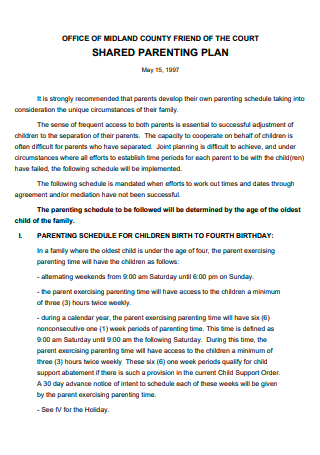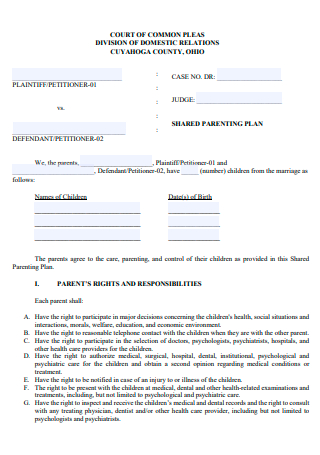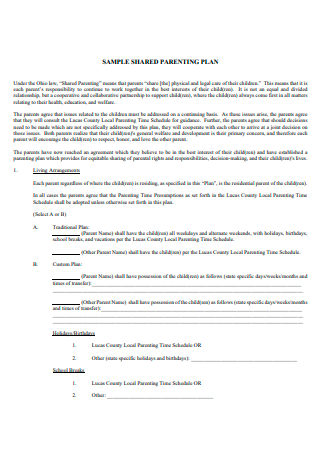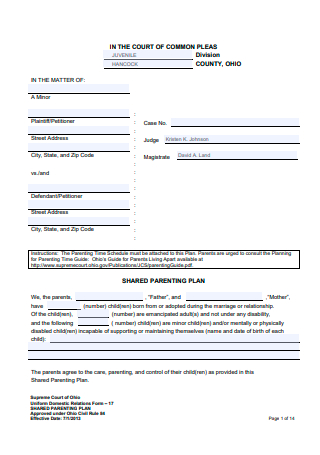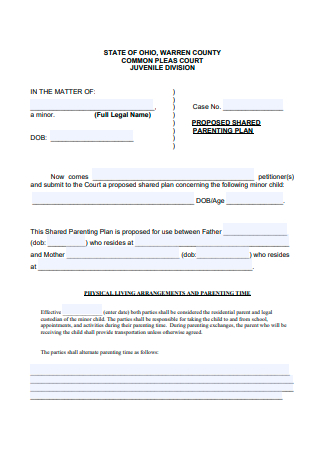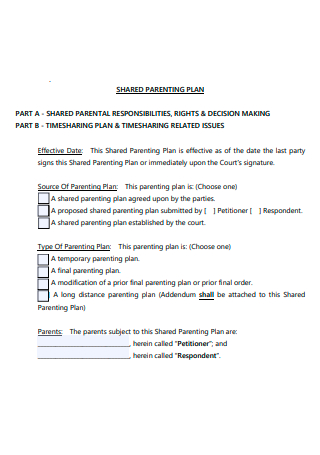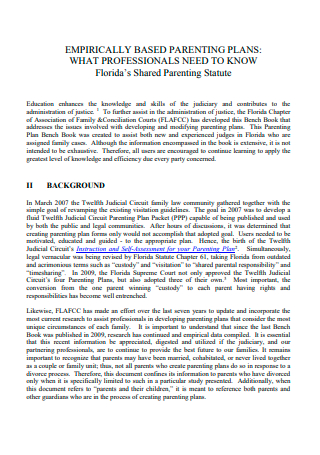7+ Sample Shared Parenting Plan
FREE Shared Parenting Plan s to Download
What Is Shared Parenting Plan?
A shared parenting plan is typically created in the period between child custody agreements. It seeks to maximize parental involvement in a child’s life on an equal footing. It contributes to a more stable environment than having only one parent as the primary custodian or guardian of the child. Shared custody arrangements are rotated on an equal basis in a shared parenting plan. As a result, both parental figures have equal say in things concerning the child. Despite the physical separation of parents, a shared parenting plan is excellent for fostering child-parent relationships. Parents have equal rights in making decisions for the betterment of their children.
A child’s well-being is jeopardized when he or she is shuttled back and forth between two parents. Healthy marriages are required for the sake of the children. However, if that is not possible, a divorce becomes a preferable option. Because visible parental conflicts can have an impact on a child’s mental and emotional wellbeing. The next best option is divorce and child custody with shared parenting arrangements. It’s a better overall approach to a really bad circumstance.
Benefits of Shared Parenting Plans
Marriage is frequently thought to be a lifelong commitment. And a divorce is not the most likely consequence. After all, love should last a lifetime. However, there are far too many factors, both positive and negative, that contribute to separation. Everything is between and decided by the family. Isn’t it better for a child to have both parents sign a parental consent form? And this is something that may be accomplished through joint parenting. It ultimately comes down to what is the greatest solution for the children involved.
Rotating Schedule: One of the advantages is the establishment of shared parenting routines. The child is under the care of another parent on a regular schedule. This enhances their engagement and fosters a stronger relationship. In contrast to typical child custody, both parents have an equal frequency. It could be a typical one-week on/off pattern. Where the other parent can have the child for a whole week and then the child is returned to the other parent the following week. Because there are more days involved, it is more consistent. Rather than a visitation agreement for a certain period of time during the day. Put another way, only on weekends. Parenting assessments and custody evaluations are conducted on both parents. Stable Environment: It can get off to a difficult start. Especially when everyone is striving to make changes all the time. It would be more difficult on the child psychologically. However, as time passes, the shared parenting plan filters in. It’s excellent for providing a reliable atmosphere in which the youngster does not frequently switch homes. This is especially true for a school-aged child. That erratic schedule would only make their studies more challenging. It also makes the separation less difficult to manage. Rather than a quick visitation or weekend custody. Children can also adapt to these changes because there is a good foundation at the start. Shared Decisions: This is most likely one of the most significant benefits of cooperative parenting. Making decisions together for the sake of the child is always preferable. It’s not so dissimilar than still being a relationship and married. Both parties have an equal say in what they believe is best. And if the relationship is cordial, this might be handled smoothly. They can also make joint contributions to the children’s education and financial budget. As well as shared financial difficulties. Both parents can physically care for their child. They have a greater opportunity to be physically present in their children’s needs. Amicable Relationships: To begin with, two parties must be amicable in order for a shared parenting plan to function. This could result from a mutually agreed-upon peaceful parting. And a well-thought-out custody arrangement. If both parents truly desire what is best for their children, they must not exclude the other from their children’s lives. Although factors such as their interests and poor habits could be a contributing influence. They should nevertheless cultivate a connection in which they can readily make agreements. No matter how long the couple was married, the end will always affect the flow of the rest of their lives. However, if they prioritize the rest of their family, the situation can still resolve peacefully. Whether forced or not, they must reconcile in order to maintain a decent relationship. They should not allow their hostility impact their children directly. As a result, adults must be adults in order for children to be children.
Factors Considered in Shared Parenting
Not only are both parties on probation at the beginning, but their backgrounds also contribute to their shared access. And this could have an impact on what the court considers along with other pros and cons. So, let’s have a look at some of the variables that contribute to successful shared parenting down below.
Parent’s Finances: Salary receipts and financial fact sheets from both parents would have to be considered. Both may be more relevant in a custody dispute. Shared parenting suggests that the co-parents have positive interactions. It does not, however, remove their financial obligation to support their child. They must be able to provide for their child while he or she is in their care. It denotes some financial security. The goal of shared parenting is still to focus on parenting. As a result, it may be more lenient than a sole custody agreement. Location of Both Parents: Of course, because they have a rotating schedule, their location is important. It would be more difficult on the young person if they had to travel large distances simply to see one parent. It also does not provide a steady environment, which is one of the objectives. More importantly, for the child’s education. When there is no stable environment to begin with, it is difficult to maintain a fairly constant grade. The location must also allow for simple access on both sides so that they can collaborate more easily regardless of what happens. A ready and immediate parent contact would be wise. History of Abuse (Substance and Physical) and Neglect: When parents are inattentive, a child’s life is jeopardized. When their behavior is unmonitored, kids will not only rebel, but they may also mimic harmful behavior. Children are easily swayed. Adults, in their opinion, can do no wrong. As a result, everything they see is what they think to be normal. It will not only have a psychological and emotional impact on them, but it will also increase the likelihood of them repeating the behavior. Children either misbehave or surrender pitifully to harsh parents. It is necessary to avert the harm and pain they may endure. That is why the court does not disregard those factors. As this could lead to a great deal of ailment and suffering. When they get older, they won’t be able to go back to that. It is a prophylactic approach to ensure a young person’s safety. Particularly if it comes from their own parents. Whom they once had the utmost faith in. That total betrayal would be a pain they would have to live with them even as they grew older. It would be simpler for them to take a higher, darker road. Worse, children may suffer physically and sustain injuries. There are some eventualities that must be avoided at all costs. Cordial Co-Parent Relationship: The mutual understanding between two people is at the heart of shared parenting. It serves as the foundation for the entire system to function optimally. Given that the child is the priority. Prioritizing their well-being would imply polite relations and a working partnership. Both parties must respect what the other brings to the table. They must be open to debate and change. Even if arguments are common, there should be a resolution at the end of the day. It was the only way they could devote their entire attention to the child. And, because it’s shared parenting, it’s ideal if the child doesn’t witness any more arguments. It’s a kind of ironic consolation. Working Schedule: In order to share their time fairly, both parties must reach an agreement on custody arrangements. It’s critical that they agree on this. A child’s time with each of his parents is priceless. Nobody wants to squander that on squabbles. A common schedule rotation is one week off followed by one week on for each parent. As a result, they each have the same amount of time to be a parent. However, there must be exceptions, such as birthdays and special occasions. It would be ideal to include this in your shared parenting plan. It is critical to plan how both parties will reconcile with their allotted amount. Everyone involved would have to adjust to the new situation. Their willingness to make this work must be visible on the surface. Work schedules from each parent may also play a role. Or their willingness to be present for their child. Parenting Abilities: Parenting is a difficult task. No matter how much time and effort was put into learning how to be a parent. There are far too many variables that can change the wind at any given time. And there are far too many competing viewpoints that could sway the outcome. A person, on the other hand, can learn how to be a parent. It does not have to be perfect. All a child could ask for is something flawed but proper. Guidance and affection can sometimes compensate for the gaps in between. Regardless of the circumstances, being present at critical times can make a youngster feel valued. Parents must also be aware of their child’s needs. If they have any medical conditions, they must be given special treatment. Being a nice human being is not a difficult task. As a result, being a good parent isn’t too much to ask. Being present, guiding, loving, and being understanding are already excellent parenting skills. If a parent is sincere enough to understand their child, the sentiment may be reciprocated.
Steps On How to Create a Shared Parenting Plan
We may deduce some of the processes involved in creating a shared parenting plan based on the characteristics listed above. It would be critical to determine the priorities on which the two parties could easily agree. Here’s how it works:
-
Step 1: Identifying Your Child’s Best Interest
The youngster is, without a doubt, the most stressed party in this agreement. Which raises the issue, “How Can We Prioritize the Child’s Best Interest?” This could be accomplished through simple comprehension and the minimization of complexity. It entails understanding what they need best and what they require both now and in the future. It’s the security and presence that their divorced parents provide. It provides children with the certainty that their parents still love and cherish them. Their education and learning may also be in their best interests. Everything in this strategy revolves around that priority.
-
Step 2: Schedules and Shared Decisions
When it comes to legal issues, the parents must agree on how to address them ahead of time. Most importantly, who is capable of handling it. Who makes the important decisions, or what processes should be taken before making a large decision? Aside from that, they must adhere to their job schedule. Work and other activities can all have an impact on availability. As a result, there must be mutual understanding in the case of exceptional circumstances. Time management is essential for maintaining a stable atmosphere. There needs to be a discussion on how consultation may take place. It all comes down to recognizing what your priorities are.
-
Step 3: Finances
The child’s present and future are both crucial considerations. Finances for their education and needs must be agreed upon. Identifying goals might help you plan your budget and expenses. It assists the parent in better managing their resources. It also promotes financial assistance on both sides. What is the amount of child support? How much money is spent on their education and future? How should the monetary contribution be handled? All of these are essential questions. And they must be addressed in some way by this parenting plan.
-
Step 4: Communication
Communication is essential in any relationship. If there is a line of communication, it is easy to recognize what both parties could do better. It’s also easier to make clear decisions in the best interests of the child.
FAQS
What Is the Difference Between Child Custody and Shared Parenting?
Child Custody means having sole custody of the child and having the most power in deciding what is best for them. Shared parenting denotes equal opportunity and decision-making for a child’s well-being. Most parents spend roughly equal amounts of time with their children. As it attempts to maximize their involvement in their child’s life. While child custody is primarily concerned with what is best for the child.
Why Is It Important to Make a Shared Parenting Plan?
The Shared Parenting Plan outlines both parents’ involvement in their child’s life. It’s the result of a mutually agreed-upon discussion about their involvement and parenting. It can aid in the clarification of problems and the search for better solutions that provide equal chance to both parties.
Can We Make Our Own Shared Parenting Plan?
Without a doubt. A shared parenting plan does not have to be a legally binding contract. It could be a peaceful solution to a difficult problem. So, if both sides are open to shared parenting, they can seek advice from knowledgeable individuals on what should be included in their shared parenting plan agreement.
Separation is not a good circumstance for a child. Shared parenting is the best next step. And if you want to make your own agreement, just look over the shared parenting plan templates listed above! Make the best decision for your child.
